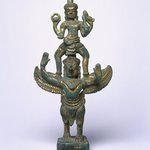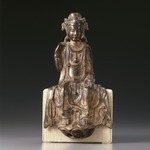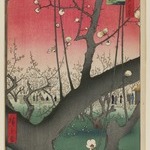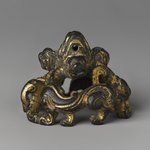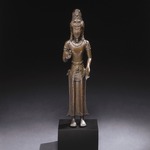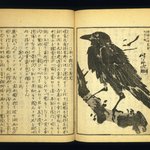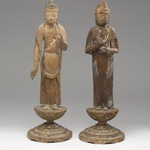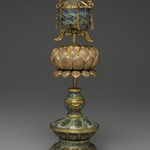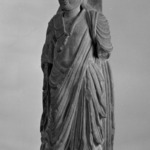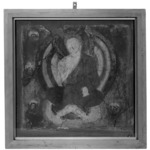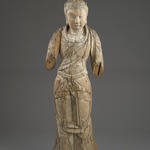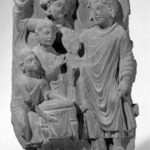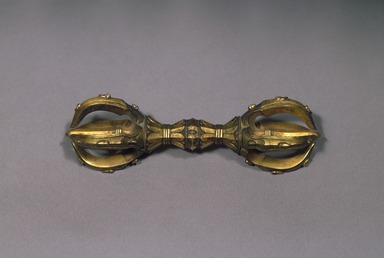
Gokoshima (Five-Pronged Vajra)
Asian Art
On View: Asian Galleries, Southwest, 2nd floor
A stylized representation of a lightning bolt, called a vajra, has long been an important emblem of power in Buddhist teachings and art. Vajras usually look like two-sided tridents, with prongs on both ends of a shaft, but their heads can have one, three, five, or six prongs. Esoteric Buddhism is called Vajrayana, or the “way of the vajra,” because the lightning bolt represents the active, forceful approach to enlightenment, one that cuts through ignorance and fear.
In esoteric Buddhist practice, initiated worshippers often hold a vajra and a hand bell, known in Sanskrit as a ghanta. The vajra symbolizes action or method, and the bell represents wisdom. Buddhists believe that these two complementary qualities must be combined and balanced in order to gain insight and progress toward enlightenment.
In esoteric Buddhist practice, initiated worshippers often hold a vajra and a hand bell, known in Sanskrit as a ghanta. The vajra symbolizes action or method, and the bell represents wisdom. Buddhists believe that these two complementary qualities must be combined and balanced in order to gain insight and progress toward enlightenment.
MEDIUM
Gilt bronze
DATES
12th–14th century
PERIOD
Late Heian Period to Kamakura Period
DIMENSIONS
1 3/4 × 1 3/4 × 7 5/8 in. (4.4 × 4.4 × 19.4 cm) (show scale)



COLLECTIONS
Asian Art
ACCESSION NUMBER
71.165
CREDIT LINE
Gift of Bernice and Robert Dickes
CATALOGUE DESCRIPTION
Vajra ritual object
Double five-pronged vajra (go-ko) with three flames on each prong except central one. Central grip consists of two bands of bound lotus petals.
Vajra is a Sanskrit term for a lightning bolt. It is carried as a weapon by various Hindu and Buddhist deities. In esoteric Buddhism, the vajra is a central emblem because the pure energy of lightning delivers a swift, powerful, and precise blow that shatters what it touches, much as enlightenment can deliver a swift, powerful, and precise blow that shatters ignorance and other forces of darkness. In ancient India, the vajra was depicted as a forked weapon. The more elaborate form shown here developed later in India and became the standard depiction of the vajra throughout Buddhist Asia.
Condition: Good, except has been cleaned recently (patina removed)
EXHIBITIONS
MUSEUM LOCATION
This item is on view in Asian Galleries, Southwest, 2nd floor
CAPTION
Gokoshima (Five-Pronged Vajra), 12th–14th century. Gilt bronze, 1 3/4 × 1 3/4 × 7 5/8 in. (4.4 × 4.4 × 19.4 cm). Brooklyn Museum, Gift of Bernice and Robert Dickes, 71.165. Creative Commons-BY (Photo: Brooklyn Museum, 71.165_SL1.jpg)
IMAGE
overall, 71.165_SL1.jpg. Brooklyn Museum photograph
"CUR" at the beginning of an image file name means that the image was created by a curatorial staff member. These study images may be digital point-and-shoot photographs, when we don\'t yet have high-quality studio photography, or they may be scans of older negatives, slides, or photographic prints, providing historical documentation of the object.
RIGHTS STATEMENT
Creative Commons-BY
You may download and use Brooklyn Museum images of this three-dimensional work in accordance with a Creative Commons license. Fair use, as understood under the United States Copyright Act, may also apply.
Please include caption information from this page and credit the Brooklyn Museum. If you need a high resolution file, please fill out our online application form (charges apply).
For further information about copyright, we recommend resources at the United States Library of Congress, Cornell University, Copyright and Cultural Institutions: Guidelines for U.S. Libraries, Archives, and Museums, and Copyright Watch.
For more information about the Museum's rights project, including how rights types are assigned, please see our blog posts on copyright.
If you have any information regarding this work and rights to it, please contact copyright@brooklynmuseum.org.
RECORD COMPLETENESS
Not every record you will find here is complete. More information is available for some works than for others, and some entries have been updated more recently. Records are frequently reviewed and revised, and we welcome any additional information you might have.
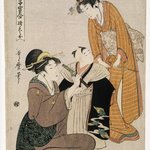
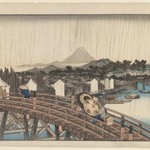
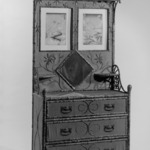





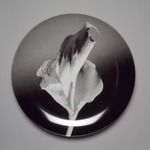





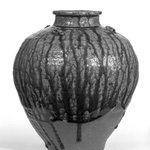
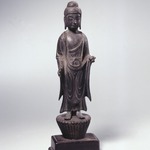


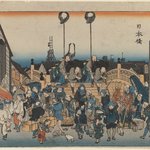

![Kakinomoto no Hitomaro [missing title cartouche: Children Parody the Six Immortal Poets (Tosei Kodomo Rokkasen)]](https://d1lfxha3ugu3d4.cloudfront.net/images/opencollection/objects/size2_sq/82.191_print_IMLS_SL2.jpg)
